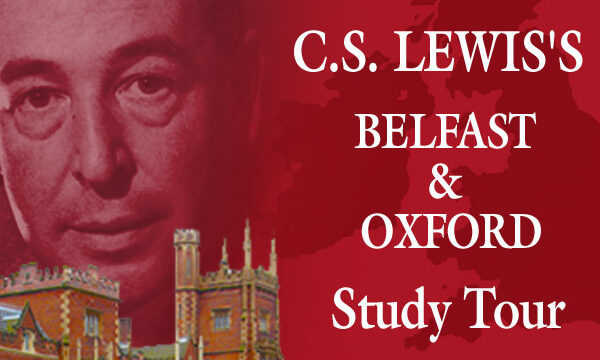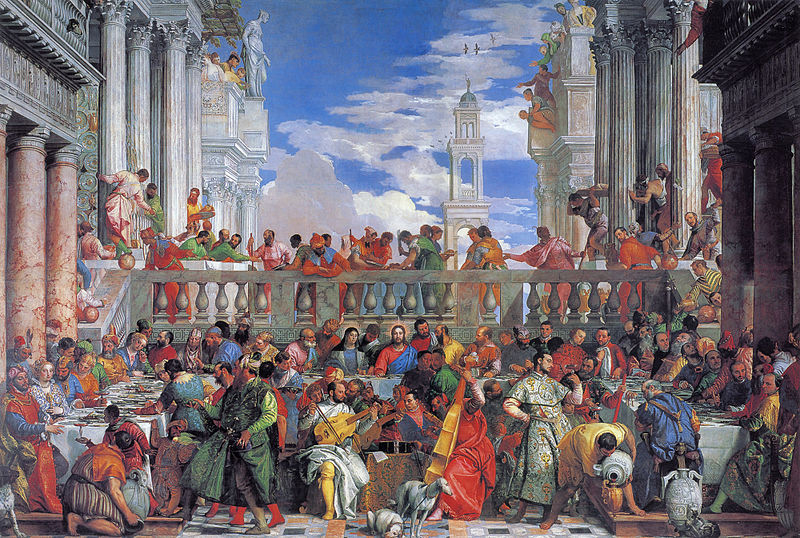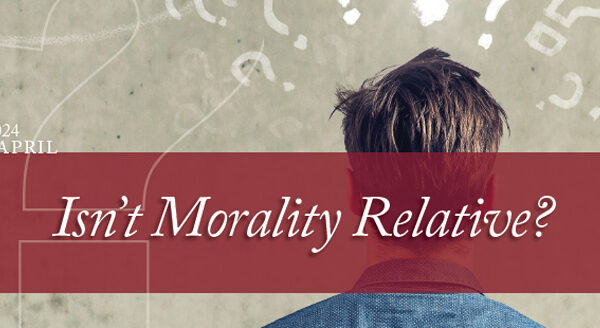Back to series



Finding Obedience in Paolo Veronese's The Wedding at Cana
Click here to open a Print - Friendly PDF
If you have visited the Louvre Museum in Paris, you have probably seen Paolo Veronese’s impressive painting The Wedding at Cana. As one of the museum’s largest pieces (approximately 21 feet by 32 feet), it is difficult to miss. Interestingly, it hangs on a large wall within a few feet of Da Vinci’s Mona Lisa. The close proximity to arguably the most famous painting in the world assures that The Wedding is seen by the majority of the 8 million people who visit the Louvre each year.
The painting depicts Jesus’ first miracle recorded in the Gospels (John 2:1–11), when at the request of His mother, He turned water into wine. As an artistic snapshot, the image reveals more than 130 individuals enjoying a wedding banquet while, along the bottom of the image, servants pour newly created wine out of ceremonial pots.
Those with formal art training undoubtedly contemplate the aesthetics and technical elements of Veronese’s work. But for the average viewer, the initial visceral reaction evoked by The Wedding undoubtedly stems from its physical enormity, which might then transition to belief or skepticism as to whether Jesus did actually turn water into wine. Thus, for many, this painting elicits the question of Jesus’s divinity.
On a deeper level, the message of The Wedding is about obedience. John’s account tells us that after the wine ran out, Mary said to Him, “They have no more wine.” Jesus’s answer, “My time has not yet come,” seems to imply that He was not going to get involved. Perhaps it was a mother’s intuition, or maybe it was a look or the inflection in His voice, but we are told that Mary next went to the banquet servants and said, “Do whatever he tells you.”1 Jesus instructs them to fill the vats with water, and the rest, as they say, is history.
When the master of the banquet tasted the new wine, he was amazed, because usually the cheaper wine was served to guests who had imbibed enough to lack a discerning palate. In this case, Jesus provided the best wine last, after the servants had obeyed Jesus’s command.
The lesson we are not to miss from Veronese is that obedience to Christ and His commands produces the good wine in our lives. Quoting the poet Addison, in A Preface to Paradise Lost C.S. Lewis wrote, “That which reigns in Milton is the most universal and most useful that can be imagined, it is in short this, ‘that obedience to the will of God makes men happy, and that disobedience makes them miserable.’” Realistically considered, the measure of our happiness is almost always in direct proportion to the level of our obedience to our Lord’s commands.
 Veronese adds visual force to his admonition for obedience through the positioning of all the characters on the canvas. Of the 130 figures in the painting, only Jesus, who is located almost directly in the center with His head surrounded by a pale glow, is looking directly at the viewer. Everyone else is busy, bustling and enjoying the party. Christ’s penetrating stare at the viewer gives added force and emphasis to Mary’s sententious command for how we are to live: be obedient and “do whatever he tells you.” The difficulty with obedience is that it is a doctrine assented to more often by the intellect than the will.
Veronese adds visual force to his admonition for obedience through the positioning of all the characters on the canvas. Of the 130 figures in the painting, only Jesus, who is located almost directly in the center with His head surrounded by a pale glow, is looking directly at the viewer. Everyone else is busy, bustling and enjoying the party. Christ’s penetrating stare at the viewer gives added force and emphasis to Mary’s sententious command for how we are to live: be obedient and “do whatever he tells you.” The difficulty with obedience is that it is a doctrine assented to more often by the intellect than the will.
After all, obedience is difficult; if it were easy, everyone would be doing it. Fortunately Christ is the model for our obedience. He reminds His disciples that “the world must learn that I love the Father and that I do exactly what my Father has commanded me” (John 14:31). Love is the key to obedience. The wondrous result was “through the obedience of the one man the many will be made righteous” (Rom. 5:19). Like the attendees portrayed by Veronese, humanity received the benefit of the good wine. Conversely, Christ asks a hard question of the disobedient, “Why do you call me, ‘Lord, Lord,’ and do not do what I say?” (Luke 6:46). When we view art, we consider the concept of image.

The Christian knows we are made in God’s image. When we fail to obey Him, we do not fully reflect the eternal image in which we were made. We are only a portion of the finished painting He desires us to be. Even delayed obedience is disobedience. C.S. Lewis reminds us, “The first demand any work of art makes upon us is surrender. Get yourself out of the way.” It is not surprising that obedience requires us to do the same.
| Notes 1. Scripture quotations are from the New International Version. |
|||

Joseph A. Kohm
Vice President for Development, CSLI & CSLI City Director, Virginia BeachJoseph A. Kohm, C.S. Lewis Institute Vice President for Development and City Director for Virginia Beach. Joe is an attorney and formerly worked as a Certified Major League Baseball Player Agent. He earned his Master’s in Management Science from the State University of New York at Oswego and both his J.D. and M.Div. from Regent University. Joe is the author of The Unknown Garden of Another’s Heart: The Surprising Friendship between C.S. Lewis and Arthur Greeves (Wipf and Stock, 2022.)

 COPYRIGHT: This publication is published by C.S. Lewis Institute; 8001 Braddock Road, Suite 301; Springfield, VA 22151. Portions of the publication may be reproduced for noncommercial, local church or ministry use without prior permission. Electronic copies of the PDF files may be duplicated and transmitted via e-mail for personal and church use. Articles may not be modified without prior written permission of the Institute. For questions, contact the Institute: 703.914.5602 or email us.
COPYRIGHT: This publication is published by C.S. Lewis Institute; 8001 Braddock Road, Suite 301; Springfield, VA 22151. Portions of the publication may be reproduced for noncommercial, local church or ministry use without prior permission. Electronic copies of the PDF files may be duplicated and transmitted via e-mail for personal and church use. Articles may not be modified without prior written permission of the Institute. For questions, contact the Institute: 703.914.5602 or email us.
-
Recent Podcasts
A Welcome Change in Apologetics
by Randy Newman, Aimee Riegert on April 19, 2024We’re burdened for our friends who don’t know...Read More
-
Questions That Matter Podcast – Samuel James and Digital Liturgies
by Samuel James, Randy Newman on April 19, 2024
-
The Side B Stories – Dr. James Tour’s story
by Jana Harmon, James Tour on April 12, 2024
-
Recent Publications
Isn’t Morality Relative?
by Christopher L. Reese on April 1, 2024It is widely accepted in the Western world...Read More
-
Do Muslims and Christians Worship the Same God?
by Andy Bannister on March 1, 2024
-
Artificial Intelligence and Its Impacts on Humanity
by John Lennox on February 13, 2024
0
All Booked
0.00
All Booked
0.00
All Booked
20599
GLOBAL EVENT: 2024 Study Tour of C.S. Lewis’s Belfast & Oxford
https://www.cslewisinstitute.org/?event=global-event-2023-study-tour-of-c-s-lewis-belfast-oxford-2&event_date=2024-06-22®=1
https://www.paypal.com/cgi-bin/webscr
2024-06-22

Next coming event
Days
Hours
Minutes
Seconds
GLOBAL EVENT: 2024 Study Tour of C.S. Lewis’s Belfast & Oxford
On June 22, 2024 at 12:00 pmat Belfast, Northern Ireland & Oxford, EnglandSpeakers

Joseph A. Kohm
Vice President for Development, CSLI & CSLI City Director, Virginia Beach
Team Members

Joseph A. Kohm
Vice President for Development, CSLI & CSLI City Director, Virginia BeachJoseph A. Kohm, C.S. Lewis Institute Vice President for Development and City Director for Virginia Beach. Joe is an attorney and formerly worked as a Certified Major League Baseball Player Agent. He earned his Master’s in Management Science from the State University of New York at Oswego and both his J.D. and M.Div. from Regent University. Joe is the author of The Unknown Garden of Another’s Heart: The Surprising Friendship between C.S. Lewis and Arthur Greeves (Wipf and Stock, 2022.)





